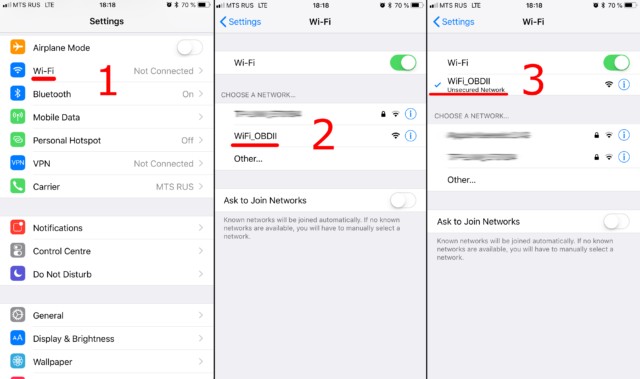Unlock the power of wireless diagnostics by connecting your OBD2 scanner via WiFi. This guide provides a step-by-step walkthrough to effortlessly link your scanner to your device and start reading your car’s data. Whether you’re using an ELM327 adapter or another WiFi-enabled OBD2 scanner, the process is straightforward. Let’s get started.
Step 1: Plug in and Power On Your OBD2 Scanner
Begin by locating the OBDII port in your vehicle. It’s usually found under the dashboard on the driver’s side. Plug your WiFi OBD2 scanner securely into this port.
Once plugged in, your scanner needs power. Typically, turning your car’s ignition to the “ON” position (or starting the engine) will power the scanner. Some scanners may have a power button that you’ll need to press. Refer to your scanner’s documentation for specific power-on instructions.
Step 2: Connect to the Scanner’s WiFi Network on Your Device
Now, grab your smartphone or tablet and access its WiFi settings. Ensure WiFi is turned on and begin searching for available networks.
Your OBD2 scanner will broadcast a WiFi network. Look for a network name that typically includes terms like “OBDII”, “OBD2”, “WIFI_OBDII”, or sometimes the brand name of your adapter (e.g., “VLINK” for VGate).
Select the scanner’s WiFi network to connect. In most cases, these networks are open and do not require a password. If a password is required, consult the documentation provided with your OBD2 scanner. It’s important to note that the network name will not be related to your car’s brand.
Step 3: Configure Your Car Scanner App for WiFi Connection
With your device connected to the scanner’s WiFi, the next step is to configure your car diagnostic app, such as Car Scanner, to communicate wirelessly.
Open your Car Scanner app and navigate to the settings menu. This is usually represented by a gear icon, often located in the top-right corner of the app.
Within the settings, find the “Adapter” or “Connection” settings. Tap on this option to configure the connection type.
Setting up Connection Type
In the connection settings, you’ll be presented with different connection options. Select “Wi-Fi” as your connection type.
Verifying IP Address and Port
After selecting WiFi, you may need to verify the IP address and port settings. For most OBD2 WiFi adapters, the default IP address is 192.168.0.10 and the port is 35000. However, some adapters may use different settings. Double-check the documentation that came with your specific OBD2 scanner to confirm these values and adjust them in the app if necessary.
Step 4: Establish Connection and Start Diagnostics
With the WiFi connection configured in your app, return to the main screen of Car Scanner. You should see a prominent “Connect” button, often green and large.
Tap the “Connect” button to establish a connection between the Car Scanner app and your OBD2 scanner. Once connected, you can begin running diagnostics, reading fault codes, monitoring live data, and exploring the full capabilities of your OBD2 scanner.
Connecting your OBD2 scanner via WiFi offers a seamless and convenient way to access your vehicle’s diagnostic information. By following these simple steps, you can quickly set up a wireless connection and start diagnosing your car with ease.

